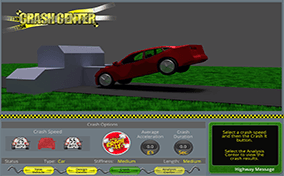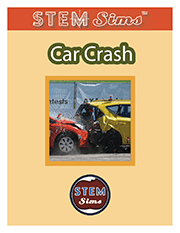Here are some definitions to help you in your investigation.
Speed - how fast or slow something is moving
Cause - something that brings about an action
Effect - a change as a result of an action
Footwell - the inside of a car down by the driver’s feet
Intrusion - how much the car frame moved into the driver
Acceleration - how quickly or slowly the driver changed speed inside the car
Risk - how likely an injury would happen. 100% means that the injury would occur. 0% means no injury would happen.
Fractures - broken bones
Vehicle - a car, truck, or SUV
Variable - something that can change
Stiffness - a measure of the firmness or ability to bend or change
Crush zone - the front end of a vehicle designed to increase driver safety
Deformation - a change in the shape of something
Safety cage - the part of a vehicle that surrounds and protects people
Frame length - the distance from the front end of the vehicle to the safety cage
What is force?
A force is any push or pull. How many times have you heard that definition of a force? Well, it's time to take it up a notch. A more encompassing definition of net force would be "a quantity that causes an object to accelerate." You probably wished that we stayed with the first definition, don't you? It's really pretty simple; if an object speeds up, slows down, or changes its shape or direction, look for a net force that causes it to change its current state.
What is acceleration?
Imagine that you're in a car with a rookie driver who has never even seen a car (not a good idea by the way). The driver turns the key, starting the car, and puts the car in gear. The driver then stomps fully down on the gas pedal. What do you think you would feel? Other than a sick feeling in your stomach from knowing that you were most likely going to crash, you would be thrown back into your seat. You really weren't thrown back though; instead, the car suddenly moved forward by accelerating and your body got in the way. The car increased its speed, then your body increased its speed from zero. So, in this case the car accelerated, which in turn caused your body to accelerate. Any time an object speeds up, slows down, or changes its shape or direction, the object is undergoing acceleration.
How are g’s converted to meters/second2?
To convert from g’s to meters/second2, multiple the g’s value by 9.80.
How are force and acceleration related?
Newton’s Second Law connects force and acceleration using the famous F = ma formula. The formula states that for a given force (F), as the mass (m) of an object increases, the acceleration (a) of the object decreases. Likewise, an object with a larger mass requires a larger force to accelerate the mass than an object with a smaller mass.
What is a collision?
Whenever two or more objects move into each other, a collision occurs. Collisions can be classified in two ways: elastic and inelastic. Elastic collisions are defined as when objects collide and bounce away from each other without lasting deformation, or without the generation of heat. Inelastic collisions do not conserve kinetic energy, though of course the total energy is conserved. The extreme inelastic collision is one in which the colliding objects stick together after the collision.
What is inertia?
Inertia is defined as the natural tendency of an object to remain at rest or to keep moving in a straight line at a constant speed.
What is momentum?
All moving objects have momentum. Think of momentum as inertia in motion. The amount of momentum, sometimes referred to as "bashing power," that an object has depends on its mass and velocity. A moving object has a large momentum if it has a large mass, a large velocity, or both. A small car can have a big momentum if it is traveling fast.
Momentum can transfer from one object to another. Newton's Third Law of Motion describes how all forces occur in equal pairs but in opposite directions. Along with a transfer of forces is a transfer of momentum. Since the interaction of forces occur at the same time, the transfer of momentum is equal. What one object loses in momentum, the other object gains. This observable phenomenon of maintaining and transferring momentum equally is called the law of conservation of momentum.
What is impulse?
Impulse is a quantity that changes an object's momentum and involves two variables: impact force and impact time. To stop an object, the object's momentum must be changed. This can be done in two ways: by stopping it quickly, which involves a large force, or by stopping the object slowly, which reduces the impact force. So, if you want to reduce the forces acting on your body during a car crash, lengthen the time the forces are applied by wearing your seat belt and using air bags.
What is energy?
Energy is traditionally defined as "the ability to do work." More precisely, that which enables an object to do work is its available energy. Often not all the energy in an object can be transformed to work—some may dissipate as heat. All energy can be considered either kinetic energy, potential energy, or energy contained by a field (such as electromagnetic waves). The law of conservation of energy states that energy cannot be created or destroyed; it may be transformed from one form into another, but the total amount of energy never changes.
How many collisions really take place during a single vehicle collision?
One Car + One Tree = Three Collisions
A driver loses control and crashes into a big tree. How many collisions occur? Newton's First Law of Motion explains that three collisions occur during the accident.
· First Collision: the car hits the tree; the tree exerts the outside force that stops the car's motion.
· Second Collision: the car stops but the driver's body keeps moving at the same speed until stopped by the impact force of the seat belt, air bag, steering wheel, or windshield.
· Third Collision: the driver's body stops, but his/her internal organs (especially the brain and heart) keep moving at the same speed; the interior of the skull, chest cavity, and abdominal wall exert the stopping force, bringing the internal organs to rest.
What is crashworthiness?
Crashworthiness refers to how well a vehicle protects its occupants in a crash. The three factors evaluated in the frontal offset crash test: 1) structural performance, 2) injury measures, and 3) restraints/dummy kinematics, determine each vehicle's overall crashworthiness evaluation.
Based on the results, passenger vehicles receive a crashworthiness rating from good to poor overall (G = Good, A = Acceptable, M = Marginal, P = Poor). If a vehicle earns a good rating, it means that in a real-world crash of similar severity, a belted driver would be likely to walk away without serious injuries.
What factors affect the survivability of a vehicle crash?
Two major factors determine the survivability of a vehicle crash: 1) the intrusion of vehicle parts into the occupant compartment and 2) the forces experienced during the crash. The greater the forces a body experiences during a collision, the greater likelihood that injuries will occur.
What is crash duration?
The crash duration is the length of time during a collision in which the vehicle decelerates from its current speed to zero.
What is a crush zone?
Crush zones are the front and rear-ends of cars that should absorb crash energy. Safety cages are the occupant compartments that should remain intact in a crash so the people inside can be protected by restraint systems: safety belts plus airbags. For optimum crash protection, the structural elements of crush zones should bend and crumple, absorbing crash energy and allowing restrained occupants to decelerate with an intact occupant compartment. This shortening of the crush zone provides the distance needed to decelerate restrained occupants, allowing them to experience lower forces than if they had stopped abruptly.
Crush zone stiffness and length influence crash capability in a two-vehicle collision. If the heavier vehicle is also stiffer, then the lighter car crushes more in addition to being knocked backward. However, if the heavier vehicle has a long crush zone as soft as the lighter car's, both cars crush equally. With sufficient crush space, the crash energy can be absorbed by both vehicles' crush zones so that people in the lighter vehicle experience diminished injury-causing crash forces. Crush zone geometry is another design feature influencing compatibility.
What is a safety cage?
Safety cages are the occupant compartments that should remain intact in a crash so the people inside can be protected by restraint systems. If a car's front-end structure absorbs and manages the crash energy so the occupant compartment remains largely intact, with little or no intrusion, then the dummy's movement is likely to be controlled and injury measures are likely to be low. In contrast, poor structural design means greater likelihood of poor control of the dummy and high injury measures.
The way to protect people in serious frontal crashes is to ensure the occupant compartment, or safety cage, remains intact. When this happens, the restraint system—the safety belts and airbags—can prevent significant injuries, even in serious crashes. But when major intrusion occurs, even the best restraint system cannot prevent all injuries. It's the same concept as shipping a fragile object—it doesn't matter how well it's protected by foam or other packaging inside a box; if the box gets seriously damaged during transit, the object inside is likely to break. Today, more of the vehicles we test have good structural designs and their occupant compartments, or safety cages, remain largely intact.
 During the 1970s, the United States averaged around 50,000 traffic deaths per year, while over the most recent decade, this number was reduced to about 32,000 per year. One of the major reasons for this reduction in traffic deaths was vehicle design improvements that offered greater protection to vehicle occupants during crashes. Can you design a vehicle that best protects people during a crash? Sharpen your engineering skills and start this investigation.
During the 1970s, the United States averaged around 50,000 traffic deaths per year, while over the most recent decade, this number was reduced to about 32,000 per year. One of the major reasons for this reduction in traffic deaths was vehicle design improvements that offered greater protection to vehicle occupants during crashes. Can you design a vehicle that best protects people during a crash? Sharpen your engineering skills and start this investigation.

